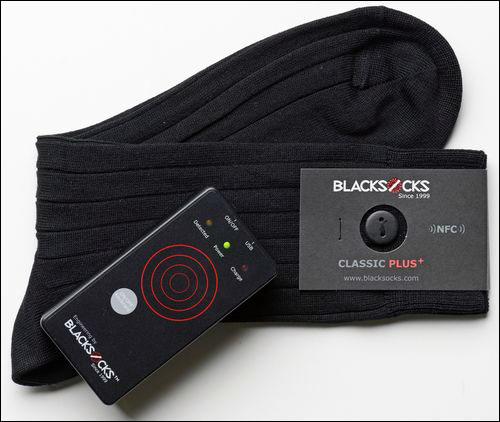Men who dress well but suffer from poor organizational skills have a new option for keeping track of their black dress socks and ensuring that they’re properly matched. The solution comes from Blacksocks, a Swiss company that provides a subscription service consisting of replacement black dress socks, in order to ensure that a man never has to venture to work wearing mismatched or faded socks. Until now, however, once the company’s socks arrived at a user’s house, anything could happen. The socks could become lost in a dryer or end up mismated, for example—thus, a man could arrive at his office wearing a new black sock on one foot, and a faded, overwashed one on the other. But such problems can now be avoided, the firm reports, thanks to radio frequency identification.
Blacksocks’ Smarter Socks system employs button-shaped 13.56 MHz high-frequency (HF) RFID tags, one sewn onto each sock, and a small RFID reader paired to an Apple iPhone via a Bluetooth connection.
Blacksocks released the Smarter Socks system this fall as a solution that is part practicality and part fun, explains Samy Liechti, the entrepreneur behind the company’s subscription service and Smarter Socks concept. His concept of helping men with socks began in 1998, Liechti says, based on the fact that “men are lazy,” and thus prone to mistakes when it comes to footwear. A Blacksocks “sockscription” consists of several pairs of Italian-made dress socks, to be replaced at regular intervals, such as three times a year. The company began shipping socks to customers in Switzerland; a large percentage of its customers are now in the United States, as well as in Germany.
The firm targets men who, according to Liechti, “are time-poor and money-rich. They have lots of things to do and prefer high-quality socks.” He decided that helping his customers manage their socks after they received them in the mail could offer additional benefits—and be fun—with a little technology. Liechti says he liked the idea of an application that could be loaded onto an iPhone to manage socks, but found that the phones are not yet equipped with RFID readers. So with the help of one of his former college professors, several engineers and two years of experiments, he developed Smarter Socks.
Each of the RFID-enabled socks (which the company calls Plus+ socks) comes with an HF 13.56 MHz Smart-tec smart-DOME Freestyle HT RFID tag sewn into it, with a unique ID number encoded to the tag. The tag is designed to withstand temperatures of up to 200 degrees Celsius (392 degrees Fahrenheit), making it a good choice for garments likely to be exposed to heat when laundered. The company also provides the Sock Sorter—a handheld RFID reader that it developed with the assistance of some Swiss engineers, Liechti says. A customer can download the free Blacksocks app to his iPhone. Then, upon receiving new Plus+ socks, he can use the Sock Sorter, paired to that phone, to read a tag, and follow prompts on the app to pair that sock’s tag with that of its mate.
After the socks are laundered, the wearer can put the reader to use once more, by waving it over a pile of clean socks. The Sock Sorter lights up when it detects a tag, and further alerts the user when that sock’s mate is located. In this way, Liechti explains, the user eliminate the risk of wearing one much older sock with a new one. Typically, the reader must be located between 2 inches and 5 inches from the tag in order to read it.
The app may be used not only to pair up socks, but also to calculate the number of times that they have been washed (based on the how frequently the tags have been interrogated). In addition, it also allows a user to utilize his iPhone to photograph his socks and determine whether they are black enough to continue wearing, or if one or both have become faded.
A starter kit consisting of 10 pairs of calf-length tagged Plus+ socks and a reader costs US$189.
The product was two years in development, Liechti says, beginning with the building of a prototype, once he found that no such reader yet existed that could be incorporated into the iPhone. Of the first prototype, he notes, “It looked very ugly, but it worked. So we started the design process for a first production lot of 10 readers.” The result is a much sleeker and smaller model that fits in a person’s hand. “Then we started the certification process (FCC and CE). Within this process, we realized that we had to make more changes. Finally, we got a green light for production.”
The company began taking orders for the Plus+ socks last week.



